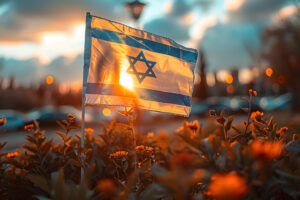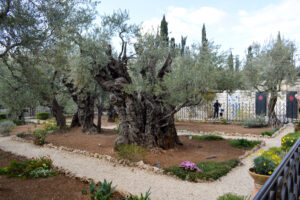As Shakespeare once said, “Although she be little, she is fierce.” This statement could not be more true than when related to the nation of Israel. Israel, a nation the size of Lake Michigan, is located in the Middle East. Many who resent her existence, refute her right to the land, and call for the death of her people surround it. However, the Israeli Jews continue to thrive as a people and community, despite constant conflict and persecution. The Israeli Jews are rich in traditions through their shared customs in Judaism, celebrations and family unity, and their ongoing struggles to survive as a people in a small nation.
Judaism has designated ways to mark the important events in a life. “Rites, rituals, and liturgies mark birth, coming of age, marriage, and death” (Goldman, 37). In Judaism, every child is related to Isaac, deserving to be brought into the world with laughter and joy (Goldman, 39). Names are significant and are not revealed until the religious ceremonies. A ceremony for boys called “the brit” is performed on the eighth day. Boys are circumcised just as Abraham circumcised Isaac. Simchat bat is a celebration of girl babies. This does not have a set date and is more relaxed. At each ceremony, parents give detailed reasons for the name they choose for their child (Goldman, 51). The coming of age ceremonies for boys and girls are known, respectively, as bar mitzvah and bat mitzvah. Boys are 13 years of age and girls are 12 or 13 years old. When they have completed these ceremonies, they are able to take their place in the synagogue and are under the obligations of adulthood, such as fasting, Yom Kipper, the Sabbath, and observing kosher laws (Goldman,53-55).
Weddings are rich in Jewish traditions. “In Judaism marriage is the natural state, it is not good for man to dwell alone,” God says in Genesis (Goldman, 70). A couple stands under a chuppah during their ceremony. It represents the new home of both. Many Rabbis believe the chuppah makes the union one in relationship to God (Goldman, 76). One well-known custom of a Jewish wedding is the breaking of the glass. This was to be a reminder of the destruction of the Temple even in your happiest moment (Goldman, 79).
Burial is quickly done after someone dies since there is no embalming. Cremation is not allowed in Judaism. They also observe a week of intense mourning called the Shiva. There is an obligation to comfort those who are mourning for the first year (Goldman, 97-99).
There are many celebrations observed by Israeli Jews. Most are deeply rooted in their faith and traditions. Shabbat is observed from sundown Friday until sundown Saturday. God rested on the seventh day and it was also a law given to Moses (Coleman). Most of the communities in Jewish sections shut down early afternoon for preparation on Friday. Large extended families come together to attend synagogue, a family Sabbath meal complete with kosher food, singing and dancing. Even teenagers take part in the gatherings with their families (Coleman). Tommie Coleman states in a recent interview, “families seem to be closer and spend time together than in America.” In families where the father is present, he places his hand on his child’s head and recites a blessing over them before the close of the meal (Kushner, 103). Non-religious Jews observe Sabbath by relaxing with family or taking walks in the park.
Rosh Hashanah is the beginning of the Jewish New year in the fall. This is a ten-day period of reflection on how their lives were lived during the year, and hopes and prayers for the days ahead. Families attend synagogue and gather to eat sweet deserts (Kushner, 106).
The Exodus became the first liberation story recorded in history (Goldman, 155). The celebration of Passover was birthed from this event. The tradition of families gathering and retelling the story of the Exodus at a meal is called the Seder, which is the most observed celebration (Goldman, 157). The observance of unleavened bread during this celebration may catch some by surprise. Coleman relates her amazement when she went to the stores in Israel to find, breads and yeast products taken off the shelf. The gathering of families around celebrations is an essential part of the unity and strength of the Jewish families in Israel. The retelling of their past is also a force that brings them together.
“In a study done in 1975, 30 years after the Holocaust, not one child could remember a time when he did not have at least a dim awareness of his parents experience of persecution” (Williams). For the second generation of survivors of the holocaust, six million Jews are
more than just a statistic—it is family, fathers, mothers, sons and daughters (Williams). The threat of persecution is still active. Today, bomb shelters are a mandatory requirement for homes in Israel. Coleman recounted the sounds of air raid sirens and feeling the deep thud and vibrations from her third story apartment of one missle that landed just a few miles away. She ran to the shelter and grabbed her gas mask and waited, for what she wasn’t sure. A few weeks before that account, the Coleman’s car was blown up due to a terroristic act (Coleman). All people in Israel, whether Jew or Arab, have a heighten awareness of possible attack at any time. Conflict is constant.
An Arab is Searching for His Goat on Mount Zion, is a poem written by Yehuda Amichai,, a naturalized Israeli citizen. Amichai poems have been translated almost as much as King David’s, some say. In the poem, he writes about an Arab shepherd who was out searching for his goat and a Jewish father searching for his son. They are both happy when they find who or what they were looking for. At the end of the poem it states, “searching for a goat or a son has always been in the beginning of a new religion in these mountains” (Reading the World). Yehuda referred to the beginning of Judaism. Abraham took his son to Mount Moriah to offer him as a sacrifice and found a goat to sacrifice in Isaacs’s place. Judaism has held and played a significant role in the lives of the Jewish people. Even nontraditional Jews celebrate or observe occasions in Israel because faith and family are so inter-connected.
The family is the center of life for Israeli Jews. “The predominant form of the family in Israel today is the traditional nuclear family comprised of a father, mother, and their biological children” (Lavee). They live in smaller living quarters. There can be 10 children or more in a 3-bedroom apartment, plus the parents (Coleman). Israeli students have what we call “dual enrollment” and are able to earn college credits but it is expected there. There does not seem to be as many distractions and luxuries for teens in Israel (Coleman). When young people are finished with high school in Israel they are required to give national service to the nation: Females for 2 years and males 3 years of service. If they do not serve in the army, they serve in hospitals, nursing homes, schools, and such. Orthodox boys are exempt and enter into a Yeshiva to prepare for religious service with study and prayer.
Israeli Jews in Israel have a rich heritage of faith and family that has sustained them through good times and bad. For generations, they have observed the customs of birth, coming of age, weddings and death, and these customs are still going strong today. The celebrations most Israeli Jews observe are steeped in faith and are centered in family togetherness. The bonding over food, dance, and song is a large part of all celebrations. Though there are still ongoing conflicts today, families remain determined to live, work and love each other and remain in the small nation of Israel, fierce as ever.
Works Cited
Catz, Ruth, and Yolk Lavee. “The Family in Israel: Between Traditional and Modernity.” N.p., 2003. Web. 20 Mar. 2017.
Colman, Tommie. Personal Interview. 8 March 2017.
Goldman, Ari L. Being Jewish: The Spiritual and Cultural Practice of Judaism Today. New York, NY: Simon and Schuster, 2000. Print.
Kushner, Harold S. To Life! A Celebration of Jewish Being and Thinking. New York, NY: Grand Central Publishing, 1993. Print.
Williams, Sandra S. “The Impact of the Holocaust on Survivors and Their Children.” N.p., 1993. Web. 10 Mar. 2017.
Natalie Ginn, 10th grade
Class project





